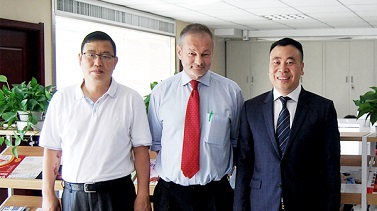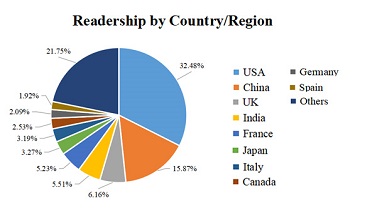Special Interview with Prof. Lakshya Bajaj
On April 18, 2025, Journal of Translational Genetics and Genomics (JTGG) had the pleasure of conducting an exclusive interview with Prof. Lakshya Bajaj, a prominent researcher in the field of molecular neurodegeneration. Prof. Bajaj, currently at the Department of Pharmacology and Toxicology at the University of Puerto Rico, shared his academic journey and insights into his work on neurodegenerative diseases.
Below are the key takeaways from the interview:
Q1: Can you briefly share your academic journey and what led you to focus on the molecular mechanisms of neurodegeneration?
Answer: My academic journey has been one part dreaming, two parts coffee, and the rest has been mostly trial, error, and optimization! Just kidding... my journey starts in India and has been full of ups and downs, twists and turns like most scientists out there. One thing I realized about myself at a very young age was that my interests and proclivities leaned toward a career in science and research. The path, however, was not very clear to me. I started out with a bachelor’s in dental surgery and soon realized I was more inclined toward exploring the unknown rather than learning about the known in science. So, shortly after finishing my BDS, I applied for a master’s in human genetics in the United States. I received offers from multiple universities but finally chose to do my master’s at Tulane University in New Orleans. I loved the city, loved the program—it was short, interactive, informative, and served as the perfect stepping stone to pursue a Ph.D. in Human and Molecular Genetics at Baylor College of Medicine, one of the leading research hubs for genetics worldwide. I joined Marco Sardiello’s group at the Neurological Research Institute at BCM. That’s where I developed my interest in neurodegeneration and neurobiology. Marco was exploring neurological disorders from a molecular perspective, and it caught my eye. As part of my thesis, we discovered the function of two genes that play key roles in the early steps of lysosomal enzyme trafficking, helping to define their role in a childhood neurological disorder known as Neuronal Ceroid Lipofuscinosis (NCL). Looking back, I believe I received the best possible mentorship and guidance in Marco’s lab, which helped me complete my Ph.D. with nearly a dozen publications. Afterward, I pursued a research fellowship with Scott Kennedy’s group at Harvard Medical School—which was an experience in itself! I then took a minor detour into the pharma industry, working at both small start-ups and flagship companies like Merck. But I soon realized that the freedom to pursue academic science and ask questions that mattered the most to me was paramount to my satisfaction. So, when an opportunity arose that allowed me to be closer to family (my wife hails from Puerto Rico), live in warmer weather near the beach, and still work on science that truly interests me—it was a no-brainer to make the move to UPR School of Medicine and start my own lab!
Q2: What drew you specifically to the intersection of RNA metabolism and proteostasis? Was there a particular scientific problem or personal motivation that sparked your curiosity?
Answer: Haan! RNA metabolism and proteostasis! I’ve never actually given that much thought to how I landed here. But looking in the rearview mirror, I think it’s because I’ve always felt like an outsider to science—or at least started as one—coming from a dental background and entering the field a bit later than others. That outsider’s perspective gave me a habit of thinking interdisciplinarily. I realized toward the end of my Ph.D. that I had spent most of my time thinking about what happens post-translationally to proteins but hadn’t paid much attention to the post-transcriptional RNA side of the story—which is equally dynamic, complex, and critical to cellular homeostasis. At that point, I also started noticing how the scientific field was split between the RNA/nucleic acid camp and the protein camp! However, People like me who left their natural habitat in search of greener pastures become kind of nomadic… They don’t do well in permanent camps. So, I decided I wanted to be one of those centrists who didn’t quite fit a single identity—maybe that’s where the Ribo-proteostasis came from! Whether we’ll succeed in this endeavor—only time will tell. But in biology, especially in this day and age when everything is so fluid, I still see these invisible boundaries, this tendency to say: “You’re not qualified to study XYZ because your past expertise lies in ABC.” And I keep thinking: it’s one cell; it’s all biology at the end. Does it really matter whether you’re studying mitochondria or lysosomes… ribostasis or proteostasis? I think we shouldn’t silo ourselves as scientists. It’s fun to go into uncharted territories—it brings fresh perspectives. I tell my students to learn a new language, a new instrument... maybe you’ll end up composing a beautiful symphony.
Q3: Your recent work explores how stress granules and RNA granules may convert into toxic aggregates in ALS and Alzheimer’s. What are some key discoveries from your studies?
Answer: Haan! It's too early to be spilling the beans! No, honestly—we're still in the early stages of this research, so I wouldn't make any conclusive claims yet. But I’ll say this: the field as a whole is arriving at a clearer understanding that stress granules—these membraneless biomolecular condensates made of RNA and proteins—may serve as precursors to pathological aggregates, not just in ALS but in a number of neurodegenerative conditions. These humble granules aren't inherently pathological. They form in response to cellular stress and are part of a highly conserved survival mechanism. But under genetic perturbations or chronic stress, they can persist and lose their liquid-like, dynamic nature, transitioning into solidlike, irreversible aggregates. That phase change—from fluid to solid—is where things start to go wrong. Our lab is trying to understand the molecular switches that govern this transition. What keeps these granules fluid? What causes them to gel or harden? We're especially interested in how these processes contribute to the nucleation events that drive aggregation. But we're also looking at the other side of the coin: disassembly. Because just as important as assembly is the cell's ability to take granules apart once the storm has passed. We're investigating the mechanisms that control granule clearance via lysosomal or autophagic pathways. Ultimately, we hope to map this lifecycle of stress granules—from assembly to disassembly—and identify the molecular safeguards that keep this process fluid and reversible. That could open the door to therapeutic strategies aimed not at clearing end-stage aggregates, but at restoring granule dynamics before they become pathological.
Q4: Working in Scott Kennedy’s lab at Harvard must be intellectually stimulating. How has this experience shaped your way of thinking or influenced your scientific approach?
Answer: Intellectually stimulating would be an understatement… it was more like an intellectual rewiring! I was at my dream school. Walking amongst these giants who have reshaped the scientific landscape time and time again, you feel small, very very small, but it also makes you realize how much farther you can go and the only limits are the ones you have set for yourself! We had George Church’s lab on the left of our lab, David Reich’s on the right, David Sinclair’s lab a few floors up and I can go on and on, and you feel this constant rush of I am here I need to do something big! But what I realized was common amongst these great scientists was that they were challenging the basics of what was known or what most of us thought was known, and through careful analysis and a childlike inquisitiveness, they were challenging science on an everyday basis and in turn discovering new scientific paradigms! The experience I had while working at Scott’s lab is something I’ll cherish forever! One of the biggest influences he had on my way of thinking, which I have carried forward to my own lab and always tell my students, is “Let the Biology guide you,” and for the longest time, I had no clue what he meant! I kept on reading, going back to his office with new ideas connecting dot A to B and expecting C, and he would look at me and say, “But why don’t you let biology give you the answers!” And once again, I would be befuddled and left clueless till it finally occurred to me what he really meant - all he wanted was to let me start with a strong unanswered question, a big gap or chiasm in the field, and design an unbiased, rigorous screen such that the screen itself provides you an unambiguous answer to your question and then you can start your scientific inquiry! The other thing I always remember he told me is “There are no constraints here - just have fun! The day you get up and feel like this place/or this science is no longer fun and exciting for you, come and tell me! The only reason we are in it is for the fun and excitement, and if you’re not getting that, it’s time to rethink your choices!” And you may not believe it, but I just told that dialogue to my graduate student yesterday, verbatim!
Q5: Looking ahead, are there any other areas of your research career that you are interested in or that you would like to continue to work on?
Answer: Oh, we are just getting started. The lab has just completed its one-year anniversary yesterday! Who knows where the science will take us... but for now, we are trying to set our temporary camp at the cusp of homeostatic mechanisms, especially ribo-proteostasis mechanisms that are at play prior to aggregate formation in neurological disease of aggregates or aggrephagies and homeostatic mechanisms after the aggregate formation in terms of neuron-glia crosstalk. We strongly believe that unless we first understand how these processes function under normal conditions, we won’t be able to truly grasp what goes wrong when disease sets in — or how these processes might change across different stages of the same disease! The same pathways, which could potentially be homeostatic in nature in the early stages of the disease, might become pathological in later stages, so it’s critical that we have a better understanding of what biology wants to do to keep things under homeostasis and when exactly pathology begins! The other crucial aspect we are working towards is establishing better and more relevant models of disease, which will be another big step for our lab! We are looking towards patient-derived organoids, especially multilineage brain organoids, which could help us model different neurological diseases. To sum up, our vision for the next decade centers on developing robust and tractable disease models, alongside a deeper understanding of the molecular pathways that are active before aggregate formation — such as stress granules — and those that emerge afterward, particularly through neuron-glia crosstalk. Thank you. It was lovely talking with you! Thanks for the opportunity.
Click the link for the full interview: JTGG Academic Talks
About Prof. Lakshya Bajaj

Prof. Lakshya Bajaj is a distinguished neuroscientist and geneticist, currently an Assistant Professor in the Department of Pharmacology and Toxicology at the University of Puerto Rico School of Medicine. He earned his Ph.D. in Genetics and Genomics from Baylor College of Medicine, where he contributed significantly to the understanding of lysosomal enzyme trafficking and its implications in neurodegenerative diseases. Following his doctoral studies, Prof. Bajaj completed a postdoctoral fellowship at Harvard Medical School in the lab of Prof. Scott Kennedy, focusing on the dynamics of RNA granules and their role in gene regulation. His research has been recognized with prestigious awards, including the NIH Ruth L. Kirschstein National Research Service Award and the Space Genetics Consortium award at Harvard Medical School. Prof. Bajaj's current work centers on the interplay between RNA metabolism and proteostasis in neurodegenerative disorders, aiming to unravel the molecular mechanisms underlying diseases such as ALS and Alzheimer's. Through his interdisciplinary approach, combining genetics, molecular biology, and neuroscience, he continues to advance the field's understanding of neurodegeneration and identify potential therapeutic targets.
Editor: Iris
Language Editor: Catherine Yang
Production Editor: Ting Xu
Respectfully Submitted by the Editorial Office of Journal of Translational Genetics and Genomics










